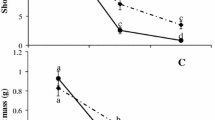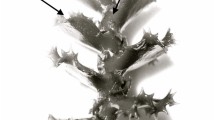Abstract
Alternanthera philoxeroides (Mart.) Griseb. is one of many aggressive invasive plants that can grow in diverse habitats. Aquatic A. philoxeroides forms dense floating mats over the water surface. However, when water levels decrease during winter, some mats become stranded on exposed sediments and are thus exposed to air. Do the stems of these mats possess the capacity to develop new shoots during the next growing season? In this study, we examined the sprouting of sediment-stranded over-wintering mats of A. philoxeroides. Stems of the over-wintering mats were divided into three types (dry, withered, and fresh stems) depending on moisture content and were immersed in water for 4 weeks to observe the sprouting of axillary buds and roots. The results showed that withered stems yielded much more biomass than dry or fresh stems. Stem moisture content significantly affected the sprouting rate and the length growth rate of buds and roots. Dry stems lacked reproductive capacity. The sprouting rate and length growth rate of the buds and roots were higher in fresh stems than in withered stems. Furthermore, the mean values of the bud sprouting rate and the bud length growth rate were highest during the first week, i.e., most of buds sprouted within 1 week or less. Our results suggest that more than 70% (on a dry weight basis) of the stems in stranded mats possessed rapid sprouting capacity even after over-wintering on the sediment for more than 2 months. This strategy may be an adaptation to the fluctuations inherent in many aquatic habitats, and it possibly explains why A. philoxeroides can flourish even after a dry winter.


Similar content being viewed by others
References
Baker, H. G., 1962. Weeds-native and introduced. Journal of California Horticulture Society 23: 97–104.
Baker, H. G., 1965. Characteristics and modes of origin of weeds. In Baker, H. G. & G. L. Stebbins (eds), The Genetics of Colonizing Species. Academic Press, New York: 147–172.
Baker, H. G., 1967. Support for Baker’s law—as a rule. Evolution 21: 853–856.
Barrat-Segretain, M. H., 1996. Strategies of reproduction, dispersion and competition in river plants: a review. Vegetation 123: 12–27.
Barrat-Segretain, M. H., G. Bornette & A. Hering-Vilas-Bôas, 1998. Comparative abilities of vegetative regeneration among aquatic plants growing in disturbed habitats. Aquatic Botany 60: 201–211.
Cook, C. D. K., 1987. Dispersion in aquatic and amphibious vascular plants. In Crawford, R. M. M. (ed.), Plant Life in Aquatic and Amphibious Habitats. Special Publication British Ecological Society, Vol. 5. Blackwell Scientific Publications, Oxford, England: 179–190.
Garbari, F. & M. L. Pedulla, 2001. Alternanthera philoxeroides (Mart.) Griseb. (Amaranthaceae), a new species for the exotic flora of Italy. Webbia 56: 139–143.
Geng, Y. P., X. Y. Pan, C. Y. Xu, W. J. Zhang, B. Li & J. K. Chen, 2006. Phenotypic plasticity of invasive Alternanthera philoxeroides in relation to different water availability, compared to its native congener. Acta Oecologia 30: 380–385.
Johansson, M. E. & C. Nilsson, 1993. Hydrochory, population dynamics and distribution of the clonal aquatic plant Ramanculus lingua. Journal of Ecology 81: 81–91.
Julien, M. H., 1995. Alternanthera philoxeroides (Mart.) Griseb. In Grove, R. H., R. C. H. Shepherd & R. C. Richardson (eds), The Biology of Australian Weeds. R. G. & F. J. Richardson, Frankston: 1–12.
Li, J. & W. H. Ye, 2006. Genetic diversity of alligator weed ecotypes is not the reason for their different responses to biological control. Aquatic Botany 85: 155–158.
Li, J. C., Y. H. Chu, W. P. Jiang & X. Y. Xu, 2007. Monitoring level fluctuation of Lakes in Yangtze River basin by altimetry. Geomatics and Information Science of Wuhan University 32: 144–147.
Penfound, W. T., 1940. The biology of Achyranthes philoxeroides (Mart.) Standley. American Midland Naturalist 24: 248–252.
Pesacreta, G. J., 1999. Alligator weed (Alternanthera philoxeroides) control by surface covers and Benthic Barriers. Environmental Practice 1: 102–107.
Reichard, S. H. & C. W. Hamilton, 1997. Predicting invasions of woody plants introduced into North America. Conservation Biology 11: 193–203.
Richardson, D. M., 2004. Plant invasion ecology—dispatches from the front line. Diversity and Distributions 10: 315–319.
Sainty, G., G. McCorkelle & M. Julien, 1998. Control and spread of alligator weed Alternanthera philoxeroides (Mart.) Griseb., in Australia: lesson for other regions. Wetlands Ecology and Management 5: 195–201.
Sculthorpe, C. D., 1967. The Biology of Aquatic Vascular Plants. Edward Arnold, London: 610.
Shen, J. Y., M. Q. Shen, X. H. Wang & Y. T. Lu, 2005. Effect of environmental factors on shoot emergence and vegetative growth of alligator weed (Alternanthera philoxeroides). Weed Science 53: 471–478.
Tao, Y., S. F. Chen & M. X. Jiang, 2004. Morphological adaptation of Alternanthera philoxeroides (Mart.) Griseb to the change of water. Resources and Environment in Yangtze Basin 13: 454–459.
Vogt, G. B., J. U. McGurie Jr. & A. D. Cushman, 1979. Probable evolution and morphological variation in South American Disonychine flea beetles (Coleoptera: Chrysomelidae) and their Amaranthaceous hosts. Technical Bulletin 1593, U.S. Department of Agriculture, Agricultural Research Service, Washington, D.C.: 148 pp.
Wang, Z. X., 1959. A limnological survey of lake Liang-Tze. Acta Hydriobiologica Sinica 3: 352–368.
Wang, B. R., W. G. Li & J. B. Wang, 2005. Genetic diversity of Alternanthera philoxeroides in China. Aquatic Botany 81: 277–283.
Xie, Y. H. & D. Yu, 2003. The significance of lateral root of in P acquisition of water hyacinth. Aquatic Botany 75: 311–321.
Xu, C. Y., W. J. Zhang, C. Z. Fu & B. R. Lu, 2003. Genetic diversity of alligator weed in China by RAPD analysis. Biodiversity Conservation 12: 637–645.
Ye, W. H., J. Li, H. L. Cao & X. J. Ge, 2003. Genetic uniformity of Alternanthera philoxeroides in South China. Weed Research 43: 297–302.
Acknowledgments
The authors would like to thank two anonymous reviewers for their constructive comments on the manuscript. We also want to thank Dr. Manghui Tu for his work on the manuscript and Drs. Heyun Wang and Jinwang Wang for their assistance with the experiment. The State Key Basic Research and Development Plan of China (G2000046803) and the Natural Science Foundation of China (30570169 and 30870232) supported this research.
Author information
Authors and Affiliations
Corresponding author
Additional information
Handling editor: S. M. Thomaz
Rights and permissions
About this article
Cite this article
Liu, C., Yu, D. The bud and root sprouting capacity of Alternanthera philoxeroides after over-wintering on sediments of a drained canal. Hydrobiologia 623, 251–256 (2009). https://doi.org/10.1007/s10750-008-9693-5
Received:
Revised:
Accepted:
Published:
Issue Date:
DOI: https://doi.org/10.1007/s10750-008-9693-5




